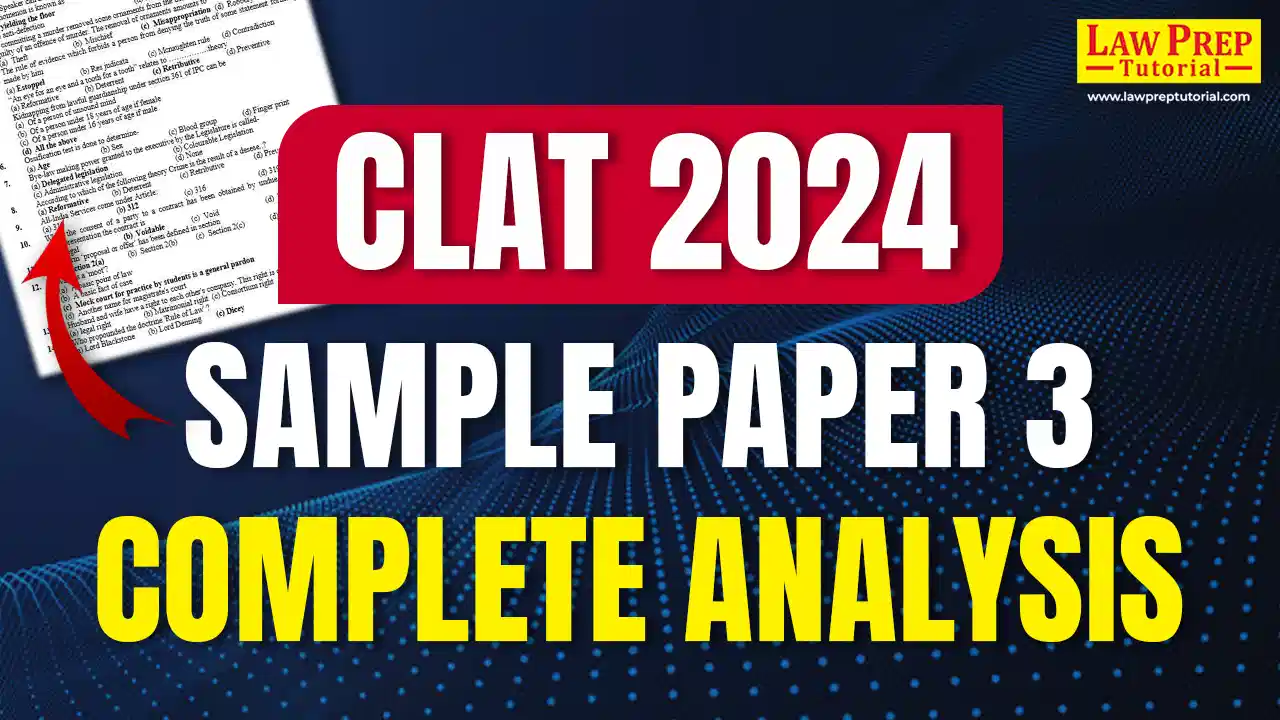The English section of the CLAT exam, with its focus on comprehension, vocabulary, grammar, and more, plays a crucial role in assessing the linguistic skills of law aspirants. As we look towards the upcoming exam, understanding the English syllabus for CLAT 2026 in detail becomes important for candidates aiming to score high.
Upcoming CLAT Exams:
So, let’s break down the CLAT English syllabus into its core components, offering insights into what to expect and how to prepare effectively.
Understanding CLAT English Section
The English section of the Common Law Admission Test (CLAT) serves as a critical measure of a candidate’s proficiency in English language skills, important for a successful career in law.
This segment of the exam is designed to assess various dimensions of English communication, including comprehension, vocabulary, grammar, and the ability to understand and analyze written material.
Role of CLAT English Syllabus
The English section in CLAT 2026 aims to evaluate:
- Reading Comprehension: The ability to understand and interpret passages, drawing inferences and conclusions from them. This skill is essential for legal studies, where vast amounts of written information must be analyzed regularly.
- Vocabulary: Knowledge of a broad range of words and the capability to understand their usage in context. A strong vocabulary for CLAT aids in the precise expression and comprehension of legal texts.
- Grammar: Command over grammatical rules and the skills to apply them correctly in writing and editing. Accurate grammar is crucial for drafting legal documents and correspondence.
- Analytical Skills: The ability to dissect sentences and paragraphs to identify core ideas, logical structures, and argumentative patterns. Such analytical skills are indispensable for CLAT legal reasoning and argumentation.
Weightage of English in CLAT Exam Pattern
The CLAT English section accounts for a significant portion of the CLAT exam, underscoring its importance. Although the exact weightage can vary each year, this section usually comprises about 20% of the total questions, making it one of the substantial areas candidates must focus on.
The performance in this section can greatly influence the overall score, potentially becoming a deciding factor in the competitive ranking process.
| Subject | No. of Questions | Weightage |
| English Language | 22-26 | 20% |
Also read: Comparison between CLAT UG vs CLAT PG.
English Syllabus for CLAT 2026 (What to Expect?)
Below is a quick overview of what you should expect from the English syllabus during the exam paper:
| Key Component | Description |
| Syllabus Scope | The CLAT UG English syllabus will consist of 22 to 26 questions, contributing to 20% of the total score. |
| Passage Length | Candidates will encounter unseen passages, each approximately 450 words long. |
| Source of Passages | Passages will be selected from historically or contemporary significant fiction and non-fiction writing. |
| Comprehension Level | The passages are chosen to match the comprehension level of a 12th-grade student. |
| Reading Timeframe | Candidates can read each passage in a timeframe of 5-7 minutes. |
| Assessment Focus | Following each passage, a series of questions will assess candidates’ comprehension and language skills. |
| Types of Questions | Aspirants can expect questions like: – Summarize the main points of the passage – make inferences and conclude from the information provided – comprehend primary points, arguments, and viewpoints – analyze and distinguish different arguments or viewpoints – interpret the meaning of phrases and words within the context |
CLAT English Syllabus 2026
Here is the detailed syllabus of CLAT English section:
1. Noun and Pronoun
Recognize nouns as words that represent people, places, things, or ideas within sentences. Understand the function of pronouns in replacing nouns to avoid repetition and maintain clarity in writing.
2. Verb and Tense
Identify verbs as either actions or states of being expressed within sentences. Grasp the concept of tense, including present, past, and future tense. It is to convey the timing of actions or events accurately.
3. Adjective and Adverb
Differentiate between adjectives, which modify nouns or pronouns, and adverbs, which modify verbs, adjectives, or other adverbs.
Use adverbs and adjectives properly to provide additional information. And enhance the description of nouns or verbs.
4. Preposition and Conjunction
Learn the function of prepositions in indicating relationships between nouns, pronouns, and other words in a sentence.
Understand conjunctions as words that connect clauses, phrases, or words to form complex sentences.
5. Sentence Structure and Syntax
Analyze sentence structure. This includes subject-verb agreement, sentence fragments, run-on sentences, and parallelism to ensure clarity and coherence in writing.
Master syntax rules to arrange words and phrases effectively within sentences and paragraphs.
6. Tenses
Mastery of present, past, and future tenses, perfect tenses and continuous forms. Correct usage of tenses in sentences.
7. Punctuation
Knowledge of punctuation marks such as commas, periods, question marks, exclamation points, colons, semicolons, and apostrophes. Correct placement of punctuation for clarity.
8. Subject-Verb Agreement
Ensure that the subjects and verbs match in number and person within a sentence.
9. Modifiers
Understand adjectives and adverbs as modifiers to enhance the meaning of nouns and verbs.
10. Parallelism
Maintain parallel structure in sentences to ensure consistency and clarity.
11. Active and Passive Voice
Differentiate between active voice (subject performs the action) and passive voice (subject receives the action) constructions.
12. Articles
Proper usage of definite (the) and indefinite (a/an) articles in sentences.
13. Conjunctions
Know how to use coordinating conjunctions (and, but, or), subordinating conjunctions (because, although), and correlative conjunctions (either/or, neither/nor).
14. Clauses and Phrases
Identify independent clauses, dependent clauses, noun clauses, adjective clauses, adverbial clauses, and phrases in sentences.
Focus on these grammar aspects with attention to detail and practice. With this, candidates can enhance their language skills and excel in the CLAT English Grammar section.
Must Know for Every CLAT Aspirant:
| CLAT Eligibility Criteria | CLAT Exam Pattern |
| CLAT Age Limit | CLAT Marking Scheme |
| How to Prepare for CLAT? | CLAT Preparation Books |
How to Prepare For CLAT English Syllabus?
Preparing for the CLAT English section requires a strategic approach to master comprehension, vocabulary, grammar, and other essential skills. We have covered some effective preparation tips and strategies:
1. Extensive Reading
Engage with a wide array of texts, including fiction, non-fiction, editorials, and essays. This enhances comprehension skills and exposes you to different writing styles and vocabularies.
Remember, don’t just read passively. Ask yourself questions about the main idea, the author’s intent, and the arguments presented. This active engagement improves critical reading skills.
2. Build a Strong Vocabulary
Add new words into your daily routine by learning their meanings, synonyms, antonyms, and usage in sentences. You can make the most out of technology by using apps designed to build vocabulary through games, quizzes, and flashcards.
3. Sharpen Your Grammar Skills
Revisit English grammar fundamentals, focusing on areas like tense, subject-verb agreement, and parts of speech. Moreover, solve grammar exercises from reliable sources. Regular practice helps identify common errors and improves accuracy.
4. Master Comprehension Skills
Work on passages from different genres and themes to get familiar with the variety seen in CLAT. Time your reading and question-solving to improve speed.
Next, understand the type of questions commonly asked in reading comprehension, such as inference-based, vocabulary, or main idea questions, and develop strategies for each.
5. Enhance Writing and Sentence Correction Skills
Familiarize yourself with common grammatical errors and sentence structure issues. Practice correcting sentences and improving them for clarity and conciseness.
Writing summaries or essays on current topics can improve your ability to express ideas clearly and coherently, reinforcing your grammar and vocabulary skills.
6. Use Mock Tests and Previous Year Papers
Regularly take CLAT mock tests under timed conditions to build stamina and get comfortable with the exam pattern.
After each mock, review your answers to identify weaknesses and focus your studies accordingly.
7. Stay Consistent and Review Frequently
Dedicate a portion of your daily study time to English preparation, ensuring a balanced approach across all CLAT sections.
Also, periodically review your notes, especially for vocabulary and grammar, to reinforce learning and ensure long-term retention.
8. Seek Feedback and Guidance
Engaging with peers or seeking help from tutors can provide new insights, clarify doubts, and offer constructive feedback on your progress. The best option is to join offline or online CLAT coaching to supercharge your preparation.
Wrapping Up
Mastering the CLAT exam English syllabus requires dedication, practice, and a solid understanding of language fundamentals. Familiarize yourself with the topics, practice regularly, and employ effective study strategies. With these tips, you can confidently tackle the English section of the CLAT exam. So, embrace the challenge, sharpen your language skills, and confidently take the CLAT examination!
Read more blogs
- Reading Comprehension for CLAT
- Most Important Topics for CLAT
- CLAT Kya Hota Hai?
- Vocabulary for CLAT
- How to Improve English Vocabulary?
Important Resources After CLAT Exam:



